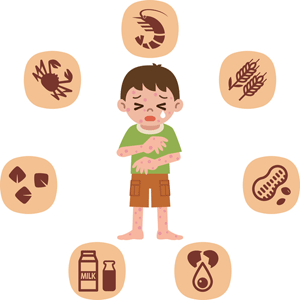
Anaphylaxis is a life-threatening allergic reaction that can occur within seconds or minutes of exposure to certain allergens.
The flood of chemicals released by the immune system during anaphylaxis can cause a person to go into shock: blood pressure drops suddenly and the airways narrow, blocking normal breathing.
Prevent exposure to triggers
The symptoms of anaphylaxis can range from mild skin changes and swelling of the face, to life-threatening lung and heart involvement.
People who have anaphylaxis, or who are at risk for anaphylaxis, must know how to reduce their risk by preventing exposure to triggers. It’s also important to learn how to recognise the early signs and be prepared for emergency treatment at any time.
The main substances known to trigger anaphylactic attacks are peanuts, tree nuts, shellfish, wasp and bee stings, latex, and drugs such as penicillin.
Most allergic reactions affect only one part of the body such as the skin or lungs. But anaphylaxis affects multiple parts of the body at once, affecting people of all ages. Without treatment, it could be deadly.
Anaphylaxis can be prevented and treated. Remember: identifying triggers and avoiding them is far better than treating an anaphylactic reaction.
Emergency action plan
An easy ABC allergy emergency action plan can save your life or that of a loved one:
A: Act fast
Early symptoms of an anaphylactic reaction may be mild and may include a runny nose, a skin rash or a strange feeling. But these signs can quickly progress into troubling symptoms, including breathing difficulties, hives, throat tightness, nausea and vomiting. It’s important to know the signs.
B: Be prepared
Early treatment with adrenaline can be a lifesaver. Always carry adrenaline with you; there’s no exception to this rule. It’s given as a shot and is available as a self-injector (also known as an auto-injector). This is highly effective, but must be administered promptly during anaphylaxis. Delays can result in death. Two injectors may be necessary to control anaphylactic symptoms.
C: Call for back-up
A person who was treated for anaphylaxis should always be taken to the nearest emergency facility for further evaluation and treatment.
More top tips for managing allergies effectively
1. Get a diagnosis from a certified allergist. Find out exactly which allergens you should avoid.
2. Learn how to correctly read ingredient labels. Read them every time you buy a product, in case the manufacturing process has changed. When eating out, ask about the ingredients and the food preparation – even a small amount of the food that you’re allergic to can cause a serious reaction. Focus on what you can have instead of on what you can’t have. Also keep a supply of safe snacks.
3. Put the allergy in perspective. Worldwide, the number of allergy deaths is small (especially for food allergies). Some reactions are fatal, but prompt emergency treatment saves lives. Most deaths are preventable.
4. If you’re allergic to stinging insects, exercise caution when they’re nearby. Wear long-sleeved shirts and pants, and don’t wear sandals or walk barefoot in the grass. Avoid bright colours and don’t wear perfume or cologne. Move away slowly and avoid slapping at the insect.
5. Drug allergies can be fatal. Remember to tell your doctor about allergies you’ve experienced in the past.
6. Always carry emergency medicine wherever you go. Wear a Medic-Alert bracelet or a mediband, stating your allergens.
7. If your child suffers from anaphylaxis, schedule meetings with teachers and caregivers before the school year begins. Inform friends and family about the allergy, and explain the implications. Ask your doctor for an official Allergy Society of South Africa emergency action plan, which is available from Allergy Foundation South Africa. Make copies of the plan for schools and caregivers, and give it to other family members as well.
8. A positive attitude is important, because the allergic child will adopt and reflect the attitude of the parents.
9. A child needs to take responsibility for their own safety as soon as possible. It’s important for their social and emotional wellbeing that they're not over-protected.
10. Learn to recognise, accept and control your anxiety. Join a support group or see a professional if necessary.
11. Avoiding your allergens is the best way to prevent anaphylaxis. Make contact with your allergist on a regular basis to make sure that you’re doing all that you can for your health.
Reviewed by Prof Mike Levin, Head of Division of Asthma and Allergy at the University of Cape Town. MBChB; FCPaed; MMed; PhD Diploma Allergology; EAACI UEMS Exam in Allergy, FAAAAI, FACAAI. March 2018
Image credit: iStock




 Publications
Publications
 Partners
Partners
















